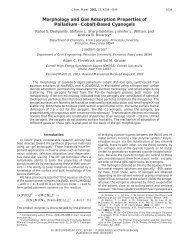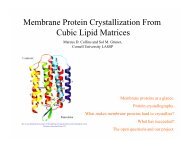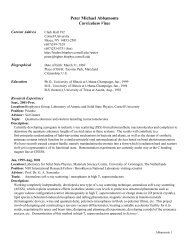Structural and Thermodynamic Characterization of T4 Lysozyme ...
Structural and Thermodynamic Characterization of T4 Lysozyme ...
Structural and Thermodynamic Characterization of T4 Lysozyme ...
You also want an ePaper? Increase the reach of your titles
YUMPU automatically turns print PDFs into web optimized ePapers that Google loves.
<strong>of</strong> WT* was provided by Marcus Collins (private communication). Cavities were identified using theprogram MSMS (34) with a 1.2 Å probe. The identified molecular surfaces were viewed using theprogram PyMol (Delano Scientific LLC, Palo Alto, CA, USA) with a script provided by WarrenDeLano (private communication).Results<strong>Thermodynamic</strong> Analysis <strong>of</strong> Fluorescence MeasurementsThe fluorescence <strong>of</strong> tryptophan is sensitive to the polarity <strong>of</strong> its local environment <strong>and</strong> can be used tomonitor protein conformation changes. Both the solvent <strong>and</strong> protein contribute to environmentalpolarity, such that protein denaturation is generally accompanied by a red-shift in tryptophanfluorescence (35). Fluorescence measurements were made on the <strong>T4</strong> lysozyme mutants at pH 3.0 <strong>and</strong>7.0. <strong>Thermodynamic</strong> analysis was performed on the pressure-induced change in the center <strong>of</strong> spectralmass (defined in Experimental Procedures).All samples exhibited two-state behavior (native versus denatured) under pressure, consistent withobservations made in other denaturation studies (36, 37). The peak intensities <strong>of</strong> the mutants werenormalized to that <strong>of</strong> WT*, which did not denature under our conditions, to correct for pressure-inducedchanges in fluorescence quenching <strong>and</strong> solvent transmission. An isosbestic point was evident in thepressure-corrected spectra <strong>of</strong> each denaturation series (Figure 6), indicative <strong>of</strong> two-state denaturation.Singular value decomposition (SVD) analysis determined that the data could be adequately described aslinear combinations <strong>of</strong> two independent SVD states. For each data set, denaturation curves reconstructedfrom the two significant SVD states fit the experimental spectra with a goodness <strong>of</strong> fit parameter, R 2 "0.9986. The reversibility calculated from the center <strong>of</strong> spectral mass upon decompression to ambientpressure was 80-93%. The low end <strong>of</strong> this range applied to samples maintained at high pressure forseveral hours. The effects <strong>of</strong> non-reversibility were apparent only at low pressure, <strong>and</strong> therefore, lowpressuredata were collected first in order <strong>of</strong> increasing pressure. <strong>Thermodynamic</strong> fits (Equation 8)performed on the centers <strong>of</strong> spectral mass yielded goodness <strong>of</strong> fit parameters, R 2 " 0.9990.12









